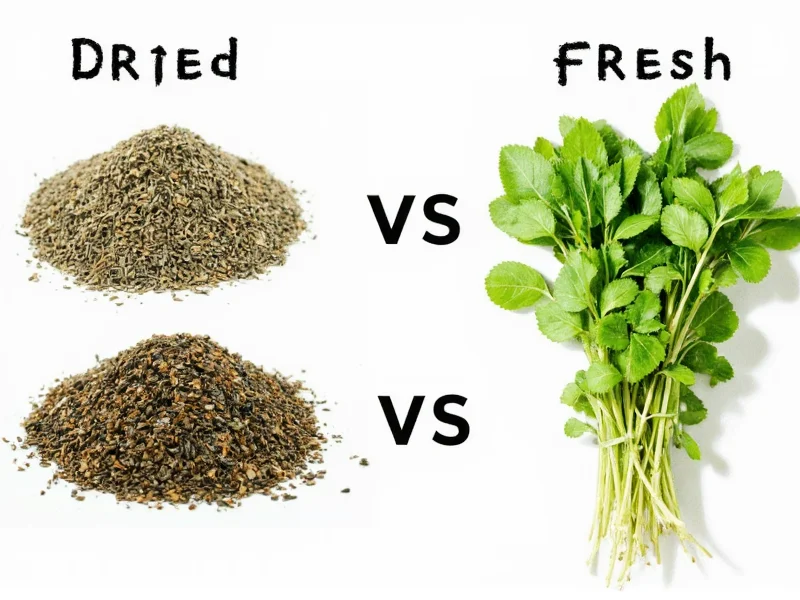Understanding dried herbs vs fresh conversion is essential for achieving perfect flavor balance in your cooking. When fresh herbs aren't available, knowing how to properly substitute dried versions prevents bland or overpowering dishes. The key difference lies in moisture content: fresh herbs are about 80-90% water, while dried herbs have most moisture removed, concentrating their essential oils and flavor compounds.
Why Dried and Fresh Herbs Aren't Interchangeable
Dried herbs contain approximately three times the flavor concentration of fresh herbs because the drying process removes water while preserving essential oils. This fundamental difference means you can't substitute them measure-for-measure. Using equal amounts of dried herbs in place of fresh will result in overpowering, potentially bitter flavors that dominate your dish.
The Science Behind Herb Conversion
When herbs dry, they lose 70-90% of their original weight in moisture. This concentration effect varies by herb type due to differences in oil content and cellular structure. Delicate herbs like basil and cilantro lose more volatile compounds during drying compared to hardy herbs like rosemary and thyme. The drying method (air-dried, oven-dried, or commercially dehydrated) also affects final potency.
Complete Dried to Fresh Herb Conversion Chart
| Herb | 1 Tablespoon Fresh = | 1 Teaspoon Dried = | Special Notes |
|---|---|---|---|
| Basil | 1/4 tsp dried | 1 tbsp fresh | Add dried basil early in cooking; fresh added at end |
| Parsley | 1/2 tsp dried | 1.5 tbsp fresh | Dried parsley loses much flavor; fresh preferred |
| Oregano | 1/4 tsp dried | 1 tbsp fresh | Dried oregano often more flavorful than fresh |
| Thyme | 1/4 tsp dried | 1 tbsp fresh | Use same amount dried as fresh in long-cooked dishes |
| Rosemary | 1/4 tsp dried | 1 tbsp fresh | Dried rosemary needs 10+ minutes to rehydrate |
| Dill | 1/2 tsp dried | 1.5 tbsp fresh | Fresh dill much more vibrant; dried loses complexity |
| Cilantro | 1/2 tsp dried | 1.5 tbsp fresh | Dried cilantro not recommended; flavor profile changes |
| Mint | 1/2 tsp dried | 1.5 tbsp fresh | Dried mint stronger; use sparingly in beverages |
When to Adjust Standard Conversion Ratios
While the 1:3 ratio works for most applications, several factors require adjustments:
- Recipe cooking time: For dishes simmering over 30 minutes, reduce dried herb amounts by 25% as flavors intensify over time
- Herb age: Dried herbs lose potency after 6-12 months; older herbs may need 20-30% more
- Dish moisture content: In dry rubs or bread doughs, use 50% less dried herbs than liquid-based recipes
- Personal taste preferences: Always start with less and adjust to taste, especially with potent herbs like oregano or rosemary
Flavor Profile Differences Between Dried and Fresh Herbs
Drying fundamentally changes herb chemistry. Volatile compounds responsible for bright, grassy notes evaporate during drying, while earthier, more resinous flavors concentrate. Fresh basil offers sweet, peppery notes with hints of anise, while dried basil develops warmer, slightly minty characteristics. Fresh oregano has citrus undertones that diminish when dried, resulting in a more pungent, concentrated flavor.
Understanding these flavor shifts helps you make better substitutions. When a recipe specifies fresh herbs for their bright top notes (like in salads or finishing sauces), dried versions won't provide the same effect even with proper conversion. Conversely, dried herbs often outperform fresh in long-simmered dishes where their concentrated flavors can properly infuse the dish.
Best Herbs for Drying vs. Using Fresh
Certain herbs maintain better flavor when dried, while others lose essential characteristics:
Herbs That Excel When Dried
- Oregano: Often develops more complex flavor when dried
- Thyme: Drying concentrates its earthy, woodsy notes
- Rosemary: Dried form works better in most cooked dishes
- Marjoram: Similar to oregano, gains depth when dried
Herbs Best Used Fresh
- Cilantro: Drying creates an entirely different, often unpleasant flavor
- Basil: Loses sweet, floral notes; becomes more minty
- Dill: Fresh provides bright, grassy flavor that dries poorly
- Parsley: Dried version lacks freshness and vibrancy
Maximizing Flavor from Dried Herbs
Follow these professional techniques to get the most from your dried herbs:
- Rehydrate before use: Mix dried herbs with a small amount of warm water or oil 15-20 minutes before adding to recipes
- Add early in cooking: For soups, stews, and sauces, add dried herbs at the beginning to allow full flavor release
- Toast spices first: Lightly toast dried herbs in a dry pan before use to awaken essential oils
- Store properly: Keep in airtight containers away from light and heat to preserve potency
Proper Storage for Maximum Shelf Life
How you store herbs dramatically affects their potency and conversion accuracy:
Fresh Herb Storage
- Treat like cut flowers: Trim stems and place in water
- Cover loosely with plastic bag in refrigerator
- Most last 7-14 days when stored properly
- Delicate herbs (cilantro, parsley) last longer than woody herbs (rosemary)
Dried Herb Storage
- Use airtight glass containers (not plastic)
- Store in cool, dark place away from stove
- Maximum shelf life: 1-2 years for optimal flavor
- Test potency by rubbing and smelling—weak aroma means it's time to replace
When Substitutions Won't Work
Some recipes simply require fresh herbs for their specific chemical properties. In pesto, fresh basil's moisture content creates the proper emulsion that dried basil can't replicate. Garnishes rely on fresh herbs' visual appeal and bright top notes that disappear when dried. Delicate dishes like ceviche or fresh salsas need the vibrant, uncooked flavor profile only fresh herbs provide.
Understanding these limitations prevents recipe failures. When a recipe specifically calls for fresh herbs in raw applications, seek alternatives rather than forcing a dried herb substitution that will compromise the dish's integrity.











 浙公网安备
33010002000092号
浙公网安备
33010002000092号 浙B2-20120091-4
浙B2-20120091-4